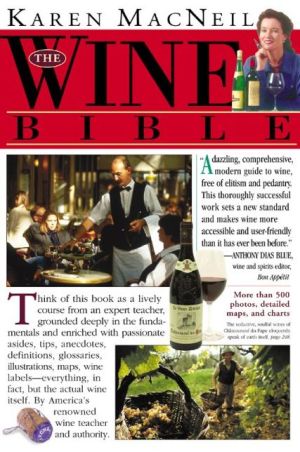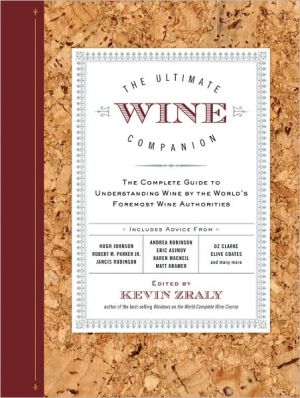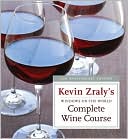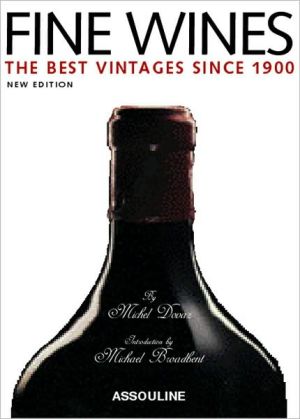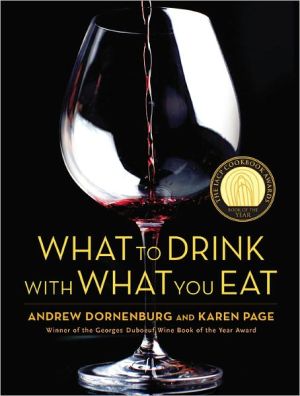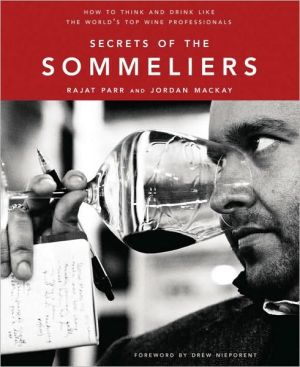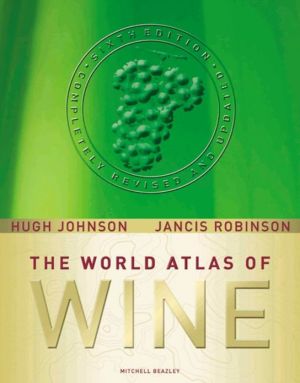Wine Bible
THE MOST COMPLETE WINE BOOK EVER. A must for anyone who loves wine, whether they are a pro or an amateur. Thorough, authoritative, and entertaining. (Robert Mondavi, founder and chairman emeritus of the Robert Mondavi Family of Wines)\ "The most informative and entertaining book I've ever seen on the subject." (Danny Meyer, co-author of The Union Square Cafe Cookbook)\ The essentials: The romance and intrigue of Burgundy of sauvignon blanc and the surprising elegance of Spain's top Riojas....
Search in google:
THE MOST COMPLETE WINE BOOK EVER. A must for anyone who loves wine, whether they are a pro or an amateur. Thorough, authoritative, and entertaining. (Robert Mondavi, founder and chairman emeritus of the Robert Mondavi Family of Wines" "The most informative and entertaining book I've ever seen on the subject." (Danny Meyer, co-author of The Union Square CafT Cookbook) The essentials: The romance and intrigue of Burgundy of sauvignon blanc and the surprising elegance of Spain's top Riojas. Italy, one of wine's most enchanting and ancient homelands. What makes a great wine great? The reason behind Champagne's bubbles. The precise and food-friendly wines of Germany. California, wine's Camelot. The lip-smackingly good wines of Australia. The complexities of Port revealed. How a vineyard profoundly affects a wine's character. Plus, matching wine with food - and mood. The secrets of professional wine tasters and how to expand your wine-tasting vocabulary. And everything else you need to know to buy, store, serve, and enjoy the world's most captivating beverage. The shimmering elegance of Veuve Clicquot, affordable luxury in a glass, page 185. Ravishing, elegant, and rich, Petrus in Ingrid Bergman in red satin, page 156. Some wines are like people... they get better as they get older, pg. 64. Sherry, the world's most misunderstood and underappreciated wine, page 437. Robert Mondavi The most complete wine book ever. A must for anyone who loves wine, whether they are a pro or an amateur. Thorough, authoritative, and entertaining.
\ Bordeaux-the word alone fires the mind with the anticipation of greatness. No other wine region is more powerful, more commercially clever, or more important as a source of profoundly complex, ageworthy wines. The challenge is to comprehend it all, for Bordeaux is the largest fine-wine vineyard on the globe. This single region covers more territory than all of the vineyard areas of Germany put together and is ten times larger than the vineyard acreage of New Zealand. In Bordeaux some 15,000 growers and dozens of top-class estates-plus thousands more of lesser standing-produce a daunting 700 million bottles of wine every year, including many of the priciest wines in the world.\ Just about halfway between the North Pole and the equator, Bordeaux lies along the path of three important rivers-the mighty Gironde, plus the two rivers that feed it, the Dordogne and the Garonne. To the immediate west is the Atlantic Ocean, and everywhere the region is crisscrossed by small streams. As we shall see, all of this water plays a critical role in shaping this region and ultimately the wines it produces.\ Both literally and psychologically, Bordeaux is a red-wine region. More than 80 percent of the wine made is red. Five red grapes are used and they are almost always blended together. The two most important grapes are merlot and cabernet sauvignon. The range of red Bordeaux is astounding. At the most basic level there are scores of utterly simple Bordeaux, such as Mouton Cadet, one of the most well-known wine brands in the world, even if it is pretty innocuous. At the most rarefied level, however, the famous Bordeaux we all hear about can be the apotheosis of refinement.\ Monumental wines, of course, do not happen everywhere. Given the vast and variable climatic and geologic forces that must come together to make a wine what it is, why is it that so many Bordeaux are considered great? When you ask Bordelais winemakers that question, chances are they will answer with a single word: terroir. The most renowned Bordeaux wines-wines such as ChGteau Latour, ChGteau Margaux, ChGteau PTtrus, ChGteau Cheval Blanc, ChGteau Haut-Brion, and so on-are said to be wines of terroir, that is, they derive their characters from singular plots of land. In addition, such wines are usually made with state-of-the-art equipment, the latest technology, and new oak barrels each year.\ Bordeaux's famous wines represent just a small fraction of all of the Bordeaux produced. Most Bordeaux wines are not wines of terroir nor are they made by ultraexpensive means. Rather, the vast majority are modest dinner wines. Wines labeled simply Bordeaux or Bordeaux SupTrieur fall into this category. Still, when most of us think about Bordeaux, we are in fact imagining those wines at the top, the cream of the crop. The complexity of these Bordeaux is often what most amazes wine drinkers. To an almost mesmerizing degree, a first-rate Bordeaux lures you back over and over again, each time revealing something new. This phenomenon has, over centuries, established the very best Bordeaux as among the most prized wines in the world.\ The Land, the Grapes, and the Vineyards\ As I've said, Bordeaux's vineyards are all in close proximity to large bodies of water. In addition to the three major rivers that dominate the region, the huge Gironde plus the two smaller but still substantial rivers, the Dordogne and Garonne, the Atlantic Ocean itself is only a one hour drive away. These nearby waterways are partially responsible for Bordeaux's early success. As of the thirteenth and fourteenth centuries, barges would dock along the wharves of the Gironde, ever ready to ferry wine to and fro between merchants and ultimately to ships headed for England. This, at a time when most other wine regions in France were relatively unknown beyond their own borders.\ Most important, the rivers and adjacent sea (warmed by the Gulf Stream) act to temper the region's climate, thereby providing the vineyards with a milder and more stable environment than would otherwise be the case. In addition, Bordeaux is edged on the south and west by vast pine forests that also help to shield the region from extreme weather. Were it not for the maritime climate and the presence of these forests, Bordeaux's vineyards would be at even greater risk of damage by severe cold snaps, potentially devastating frosts, and/or summer storms.\ The name Bordeaux derives from au bord de l'eau, meaning along the waters.\ Sometimes, of course, the proximity to water and the protection afforded by forests isn't enough. In April of 1991 Bordeaux was whipped by a terrible frost that left the vineyards bedraggled and dotted with frostbitten bald spots a quarter mile wide. In some areas 80 percent of the grapes were destroyed. In a year like this the quantity of Bordeaux can plummet, though the quality-surprisingly enough-may still be good. It all depends on the character of the growing season as a whole plus, of course, the skill of the winemaker.\ Many of the vineyards of Bordeaux-and especially of the MTdoc, including Margaux, Pauillac, St.-Emilion, and St.-EstFphe-appear quite flat. And they are, if one compares them to, say, the steeply sloped vineyards of the northern Rh(ne, those of northern Portugal, or most precipitous of all, the vineyards of Germany's Mosel region. The vineyards of the MTdoc are spread over gentle hillocks. In Pomerol and St.-Emilion these hills sometimes rise and fall a bit more. The variations in topography, combined with the specific composition of the soil, create multiple drainage patterns. And drainage is key. The best vineyards tend to be on well-drained soil of gravel and stone. In the MTdoc these deep gravel beds are frequently near the Gironde River. An old Bordeaux saying has it that the best vineyards "can see the river," and not surprisingly, if you stand in the middle of the vines at ChGteau Latour, at ChGteau Pichon Longueville Comtesse de Lalande, or at many of the other top estates, you can indeed watch the boats moving up and down the Gironde.\ It was precisely such gravelly soil that gave Graves its name. Graves (pronounced grahv), one of the important subregions within Bordeaux, produces wines that at their pinnacle evoke the subtle aroma and flavor of the gravel and stones from which they come. If the gods had been generous, every square inch of Bordeaux would have been gravel and stone. Unfortunately they were not, and it is not. The soil of many vineyards includes clay. Since water drains poorly from clay, this is usually not ideal. But, as we know, in the world of wine, no one factor can be considered out of relationship to all others. A good slope can even generally im-prove the drainage of a clay-based vineyard.\ By law, red Bordeaux wines must be made from one or more of five red grapes: merlot, cabernet sauvignon, cabernet franc, petit verdot, and malbec. Merlot, the most widely planted of these, is often described in Bordeaux as fleshy and round. Cabernet sauvignon, by comparison, is frequently credited with giving red Bordeaux its structure. Structure, which can be thought of as the architecture or framework of the wine, comes principally from tannin, and tannin is something cabernet sauvignon has in spades. Tannin also acts as a preservative in wine, which is why so many top Bordeaux can be aged for such long periods of time. Together, merlot and cabernet sauvignon make up the lion's share of most red Bordeaux.\ Cabernet franc, petit verdot, and malbec all play a much smaller role. In a Bordeaux blend they are the seasonings. Of the three, cabernet franc is the most well regarded for the enticing violet aroma it can contribute.\ For white Bordeaux wines, four grapes are permitted: sTmillon, sauvignon blanc, muscadelle, and ugni blanc. STmillon, considered the soul of white Bordeaux, is the most widely planted. With age, sTmillon takes on a wonderful honey flavor and a creamy, almost lanolinlike texture.\ STmillon is typically blended with sauvignon blanc, a wine that is its complete opposite. While sTmillon is usually creamy, sauvignon blanc virtually vibrates with zesty acidity. The root of the word sauvignon is sauvage (wild, as in wild vigorous growth). Even the flavor of sauvignon blanc can seem untamed, with a wild herb tilt to it. Only a few top white Bordeaux are exclusively sauvignon blanc, notably Pavillon Blanc from ChGteau Margaux. As for muscadelle and ugni blanc, the first provides floral hints; the latter is pretty neutral and used almost exclusively in very inexpensive white Bordeaux.\ Over generations, these nine grapes have not only proved themselves well suited to Bordeaux's climate but they also have been found to enhance one another when blended (not all grapes do). The fact that nine grape varieties are planted in Bordeaux makes the practice and philosophy of winemaking extremely different from that in Burgundy, Bordeaux's northern neighbor and rival, where there is just one leading red grape, pinot noir, and one white, chardonnay. For the Bordelais winemaker blending is critical; it is one of the methods by which complexity in wine is achieved.\ The grapes of Bordeaux were not arrived at solely because they create good flavor synergy, however. Equally important was the fact that they ripen at different times. In Bordeaux's rain- and frost-prone climate, planting several grape varieties was one of the ways growers could minimize the risk of losing entire crops to bad weather. According to the English wine writer David Peppercorn in his comprehensive book Bordeaux, the process of matching grape to ground occurred most rapidly during the last two centuries. As of 1784 thirty-four red varieties and twenty-nine white varieties could still be found in parts of St.-Emilion and Pomerol.\ Making Bordeaux\ In the last decades of the twentieth century, winemaking changed considerably in Bordeaux. For white wine, the changes were monumental. Great white wine, more fragile and less structured than red, is extremely sensitive to every element of its creation: the precise moment of the harvest, the conditions under which the grapes are picked, the length of time the juice is in contact with the skins, the temperature at which the wine is fermented, and crucially, whether or not the wine is fermented and/or aged in small oak barrels. In Bordeaux, widespread changes in these methods have resulted in fresher, creamier, richer, more deeply flavored white wines.\ As far as red winemaking is concerned, Bordeaux is a mecca of sophistication. From the mid-1970s onward, repeated advances led to wines that are less harshly tannic, easier to drink at a younger age, and yet still capable of aging.\ One of the most important advances was a new understanding of what it meant for a grape to be ripe. In the past in Bordeaux (and everywhere else in the world) grapes were picked when the sugars in them reached a certain density. By the 1980s, however, all of the top Bordeaux estates had begun to pick based not just on sugar ripeness but on a new concept called tannin ripeness. Although the ripeness of tannin is difficult to quantify scientifically, winemakers can, by repeatedly tasting the grapes, sense when the tannin in them is mature and when it is immature, or "green." Since a wine with green tannin usually tastes bitter and hard edged (even after aging), the new focus on ripeness of tannin was pivotal. It has, in short, led to more supple-tasting wines that additionally seem to age more smoothly. Bordeaux was also the first wine region to implement advanced-and often controversial-techniques for concentrating a wine's flavor, body, and, in the case of sweet wines, sweetness. Among these techniques is one called reverse osmosis, an expensive process used by the very top chGteaux for red wine. Essentially the wine is passed under pressure through a membrane that separates water molecules from alcohol. By then removing some of the water, a more densely concentrated wine can be made. Depending on who you talk to, altering the concentration and body of a wine by removing water from it is either cheating or a smart business practice. If nothing else, using reverse osmosis would seem inconsistent with the philosophy that terroir makes the wine. The chGteaux owners who use the technique, however, defend it, maintaining that the end (denser wine) justifies the means.
MASTERING WINE FRANCE ITALY SPAIN PORTUGAL GERMANY AUSTRIA HUNGARY GREECE THE UNITED STATES AND CANADA AUSTRALIA NEW ZEALAND SOUTH AFRICA CHILE ARGENTINA APPENDIXES
\ From Barnes & NobleThis 900-page reference was in the works for eight years. Author Karen MacNeil has almost nonpareil credentials: She has trained thousands of chefs, waiters, and dining fans on the fine points of wine and lives only a metaphorical grape toss away from a vineyard, residing in Napa Valley with her winemaker spouse. The Wine Bible has all the liveliness, enthusiasm, and specialist knowledge that one would expect from such an expert teacher. Utilizing histories, glossaries, anecdotes, illustrations, maps, charts, and wine labels, MacNeil demystifies a field notorious for its hermetic elitism. Her budget-minded tips and memorable descriptions make this a book that will quickly and painlessly pay for itself.\ \ \ \ \ Bon Appétit"A dazzling, comprehensive, modern guide to wine, free of elitism and pedantry. This thoroughly successful work sets a new standard and makes wine more accessible and user-friendly than it has ever been before."\ —Anthony Dias Blue, wine and spirits editor, Bon Appétit\ \ \ Bon Appetit"A dazzling, comprehensive, modern guide to wine, free of elitism and pedantry. This thoroughly successful work sets a new standard and makes wine more accessible and user-friendly than it has ever been before."\ —Anthony Dias Blue, wine and spirits editor, Bon Appétit\ \ \ \ \ Anthony Dias BlueA dazzling, comprehensive, modern guide to wine, free of elitism and pedantry. This thoroughly successful work sets a new standard and makes wine more accessible and user-friendly than it has ever been before.\ \ \ \ \ Danny MeyerThe most informative and entertaining book I've ever seen on the subject.\ \ \ \ \ Real SimpleIf it's connoisseurship you aspire to, a great place to begin learning more is The Wine Bible...\ \ \ \ \ Robert MondaviThe most complete wine book ever. A must for anyone who loves wine, whether they are a pro or an amateur. Thorough, authoritative, and entertaining.\ \
